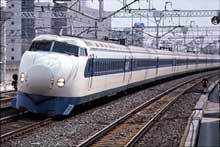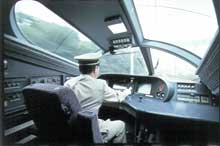|
The Shinkansen
has succeeded thanks to several kinds of technology:
(1) A streamlined body: To achieve speeds of 200 kilometers
per hour (130 miles per hour) and more, the trains needed to be as aerodynamic (to
cause as little wind resistance) as possible. That is why the
front cars of the Shinkansen trains are tapered like the nose
of an airplane.
(2) Minimizing vibration: When trains reach high speeds,
the wheels vibrate on the rails. If this vibration reaches the
passenger compartments, it can make them fall apart. To prevent
this, the passenger compartments ride on top of flatcars. These
are fitted with an air spring that uses compressed air to absorb
the wheel vibration so that it does not reach the passenger compartments.
|

A 0-series train takes a curve.
|
(3) Modern tracks: Until the Shinkansen was built, Japan
did not have the wide-gauge (1,435 millimeters wide) railway tracks
that were the standard in the rest of the world. Instead, Japanese
trains ran on narrow-gauge tracks (1,067 millimeters wide). Most
people felt that wide-gauge railway tracks were necessary to move
large numbers of people and large volumes of goods, so wide-gauge
tracks were built for the Shinkansen. And to allow the trains
to go as fast as possible, Shinkansen tracks have no sharp curves.
Also, Shinkansen tracks never cross other railway lines on the
same level, so the trains never have to stop and wait for other
trains to pass.
|

The driver's seat in the 500-series.
|
(4) Automatic Train Control: On regular trains, drivers
adjust the train's speed according to the signals they see along
the tracks. But Shinkansen trains travel at over 200 kilometers
per hour, making it almost impossible for drivers to read signals
as they whiz past. So Shinkansen trains have a different kind
of speed control system, known as ATC. With this system, speed
information is transmitted along the track and is received by
a signal attached to the driver’s seat. The ATC automatically
keeps the train running within the designated speed limit. The
Shinkansen also depends on Centralized Traffic Control, a system
that makes sure there is enough time and distance between trains
so that the high-speed train system operates smoothly and safely.
Thanks to these
technologies, the Shinkansen has been running continuously since
it first opened, with no major accidents. As of 1999, its thirty-fifth
year of operation, the Shinkansen had carried a total of about
5.6 billion passengers along its Tokaido-San'yo, Tohoku, Joetsu, and
Nagano routes. That's almost as many as all the people in the
world!
Photos: JR Central (top); JR West (bottom)
|